Cisco 8608 Router Data Sheet
Available Languages
Bias-Free Language
The documentation set for this product strives to use bias-free language. For the purposes of this documentation set, bias-free is defined as language that does not imply discrimination based on age, disability, gender, racial identity, ethnic identity, sexual orientation, socioeconomic status, and intersectionality. Exceptions may be present in the documentation due to language that is hardcoded in the user interfaces of the product software, language used based on RFP documentation, or language that is used by a referenced third-party product. Learn more about how Cisco is using Inclusive Language.
The Cisco® 8000 Series combines the revolutionary Cisco Silicon One™, IOS XR® software, and clean sheet chassis design to deliver a breakthrough in high-performance routers. The 8000 Series comprises a full range of feature-rich and highly scalable and reliable routers. Cisco 8608 is a part of a new complimentary portfolio built on Centralized Architecture based chassis design.
The Cisco 8608 is a unique platform that combines flexibility and reliability while offering investment protection. Customers can achieve unmatched reliability with redundant control and data plane via redundant route processors and redundant switch cards. Unlike distributed architecture, the forwarding decisions on centralized platforms are centrally performed. Cisco 8608 can also be operated in a non-redundant mode as well. Cisco 8608 first generation switch cards are powered by Cisco Silicon One™ Q200 ASIC. A wide variety of modular port adapters allow for high interface diversity.
This data sheet is specifically for the Cisco 8608 router. In addition to the centralized router architecture in the Cisco 8608, the Cisco 8000 Series includes two other distinct router architectures that utilize the Cisco Silicon One ASICs:
● Distributed: The Cisco 8800 Series provides the highest bandwidth via distributed chassis with a redundant control plane and switch fabric. The 8800 Series includes the Cisco 8804, 8808, 8812, and 8818. These chassis deliver up to 28.8 Tbps per line card via 100, 400, and 800G ports.
● Fixed: The Cisco 8100 and 8200 utilize Cisco’s standalone architecture to deliver full routing functionality with a single ASIC per router. Both support the full routing feature set. The 8200 has deep buffers and expanded forwarding tables, while the 8100 is targeted for data center applications with lower buffering and forwarding table scale requirements.
Learn more about Cisco 8000 distributed and fixed portfolio in the Cisco 8000 data sheet.
Large, distributed chassis have traditionally been designed to cater to the market requirement for total system bandwidth, port diversity, and redundancy. The requirements far exceeded what could be accomplished with a single NPU. The fabrics that weave together multi-NPU systems had to be provisioned to the highest bandwidth use case and deployed 100% upfront, consuming power and capital regardless of the number of installed line cards. That wisdom held true for multiple generations of core, edge, and aggregation distributed systems.
Now with the advent of dense Cisco Silicon One ASICs, we can address these roles with a new breed of centralized architectures that combine the best aspects of distributed and fixed systems. Cisco 8608 has combined the redundancy and I/O diversity of distributed systems with the economics and simple elegance of fixed platforms. As a result, Cisco 8608 delivers redundancy at an optimized cost while enabling flexibility and expandability through generational continuity. The key chassis components and their overview is captured in the table below:
Table 1. Cisco 8608
| Items |
Details |
| Maximum Bandwidth and SC ASIC |
● 12.8 Tbps, Cisco Silicon One Q200; maximum of 8 MPAs at 1.6 Tbps per MPA
|
| Chassis |
● 7RU in height with a sheet metal depth of 580 mm
● Chassis hosts the commons such as fans and power supplies, RPs, SCs, and MPAs
|
| Route Processor (RP) |
● RPs hosts the CPU and the I/O ports; RPs fit vertically in the front of the chassis
● Up to two RPs; RPs work in active-standby mode enabling control plane redundancy
● 6 core Intel CPU
● 64 GB DRAM and 256 GB SSD
● I/O Ports
|
| Switch Card (SC) |
● Cisco 8608 switch cards host the ASIC and sit within the fan trays behind the fans
● Up to two SCs work in hot standby mode enabling data plane redundancy
|
| Power Supply Unit |
● 4 power supplies that can provide N+N redundant power to the system
● Available options are 3.2 kW AC, 3.2 kW DC and 4.3kW HV
|
| Fans and Fan Spinner |
● Each fan tray has four fan modules integrated with switch card.
● 8 removable fans; N+1 fan redundancy
● In nonredundant 8608, second switch card slot needs to be occupied by a fan spinner that contains the fans only without the switch card module behind the fans
|
| Supported Modular Port Adapters (MPAs) |
● 4x400 GbE
● 24x10/25/50 GbE
● 16x100 GbE or 12x100 GbE+1x400 GbE or 8x100 GbE+2x400 GbE
|
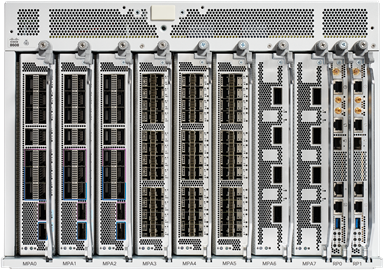
Cisco 8608 router front view
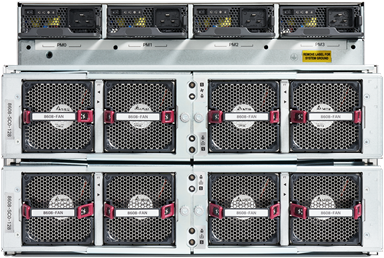
Cisco 8608 router Rear View
Silicon innovation with Cisco Silicon One ASIC
Cisco Silicon One™ is Cisco’s first routing silicon architecture to break through the 10 Tbps benchmark for network bandwidth. This is accomplished without sacrificing route capacity, packet-per-second forwarding performance, or feature flexibility. The first-generation Cisco 8608 is driven by Q200 Cisco Silicon-One 7nm ASIC which delivers 12.8 Tbps of bandwidth and delivers high-scale routing and deep buffering using HBM (High bandwidth memory), thus avoiding any off-chip memory. HBM is connected via ultra-fast silicon interface and delivers significant performance at low power.
Cisco 8608 system design innovation
The 8608 chassis utilizes a state-of-the-art orthogonal design with advanced cooling via front to back airflow, high power capacity, and new power supplies. The chassis and all data path components for the Cisco 8608 benefit from a clean sheet design that allows the systems to take full advantage of the latest technologies and Cisco’s design expertise. This design connects all forwarding path components directly without a backplane or midplane. The eight Modular Port Adapters (MPAs) along with the two route processors are vertically oriented. Every major component of Cisco 8608 was designed from the ground up, thus representing unprecedented investment and commitment to a long lifecycle for the platform.
Redundancy – Cisco 8608 introduces a new forwarding paradigm via a redundant control plane (route processor [RP] redundancy) and redundant data plane (switch card [SC] redundancy). A redundant 8608 requires two RPs and two SCs, while a nonredundant 8608 is comprised of a single RP and SC.
Investment Protection – The design of the system allows for upgrade of all the major components of the chassis such as the switch cards. This will ensure that customers’ investments into the commons are protected while Cisco launches next generation components.
Flexibility – Flexibility via MPA modularity and interface diversity. Native port speed support from 10GbE upto 400GbE. 1G support via SFP-1G-xx. Wide variety of optics support for multiple customer use cases.
Cisco 8608 switch cards sit within the fan trays at the back of the fans. Each fan tray has four fan modules integrated with the switch card. There are two fan trays per chassis. The Q200 NPU sits within the switch card, and all the forwarding decisions are driven by the switch card. Detailed characteristics of the switch card can be found in Table 3 below.
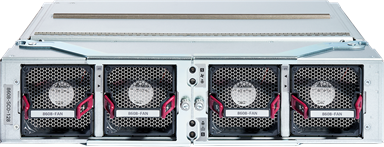
Cisco 8608 switch card
The Cisco 8608 Route Processor (RP) sits vertically in the front of the chassis handling control plane operations. In addition to other ports, the RP has the timing ports on it. The route processor is not connected to the fabric. Detailed characteristics of the route processor can be found in Table 3 below. Other specifications of the route processor Intel 6-core 2.5 GHz CPU with 64 GB of DRAM, 256 GB SSD, RS-232 console, 1 GB Management, 1x USB3.0, GPS (ToD, 10MHz, 1PPS), IEEE 1588 PTP SFP/SFP+, SyncE BITS/DTI/J.211, GNSS.

Cisco 8608 modular port adapters
The Cisco 8608 supports three different Modular Port Adapters (MPAs). The details are captured in table below:
Table 2. Cisco 8608 modular port adapters
| Modular Port Adapter |
Bandwidth |
SFP56 Physical Ports |
QSFP28 Physical Ports |
QSFP56DD Physical Ports |
MACsec |
PTP Timing Performance |
| 86-MPA-14H2FH-M |
1.6 Tbps |
- |
14 |
2 |
Yes |
Class B/C |
| 86-MPA-24Z-M |
1.2 Tbps |
24 |
- |
- |
Yes |
Class B/C |
| 86-MPA-4FH-M |
1.6 Tbps |
- |
- |
4 |
Yes |
Class B/C |
This combo MPA provides 1.6 Tbps of maximum throughput with MACsec support on all ports. The MPA can be operated either in 16x100 GbE or 12x100 GbE+1x400 GbE or 8x100 GbE+2x400 GbE modes. Additional other combinations are also possible by using breakout. QSFP28 optics are supported on the 100 GbE. This MPA is ready for Cisco Routed Optical Networking with wide DCO support including ZR / ZR+ / Bright ZR+ and all other DCO variants in the future on all 400 GbE ports. Usage of a 400 GbE port will result in some of the 100 GbE ports being shut down. The details can be found at cisco xrdocs.
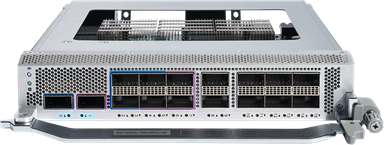
16-port 100/400 GbE QSFP28 & QSFP56DD Combo MPA
86-MPA-24Z-M
This 24xSFP56 port MPA provides 1.2 Tbps of maximum throughput with MACsec support on all ports. The MPA can be operated either in 10/25/50 GbE native mode across all 24 x SFP56 ports.
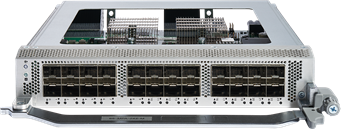
24-port 10/25/50 GbE SFP56 MPA
86-MPA-4FH-M
This is a QSFP56DD 4x400 GbE port MPA. This MPA provides 1.6 Tbps of maximum throughput with MACsec support on all ports. This MPA is ready for Cisco Routed Optical Networking with wide DCO support including ZR / ZR+ / Bright ZR+ and all other DCO variants in the future on all 400 GbE Ports. If needed the 400 GbE ports can also support 100G breakout.
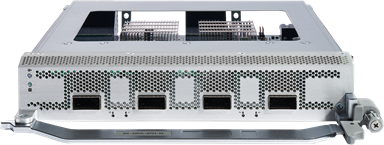
4-port 400 GbE QSFP56DD MPA
Security is a major concern for all Cisco customers. Attacks on networking equipment can have disastrous results. Network operators need assurance that the platform is secure against hardware and software breaches. The Cisco 8608 router supports hardware root of trust based on the Trusted Computing Group (TCG) and IEEE 802.1 AR standards. The Cisco 8608 is FIPS 140-2 Level 2 compliant and supports advance security features to ensure platform and OS integrity.
● Cisco secures the supply chain of every system at manufacturing time. A technology called “Chip Protection” allows customers to be assured that the hardware they receive from Cisco has no counterfeit components. This is accomplished with the use of unique identifiers that are stored inside the Trusted Anchor Module (TAM) device to identify and track components through the entire lifecycle of the Cisco 8608. The checks cover all major components, including network processors, CPUs, and Field-Programmable Gate Arrays (FPGAs).
● Every image that a customer downloads from the Cisco site is cryptographically signed using Cisco private keys. Each platform has a TAM (based on the TCG standard) that uses built-in cryptographic functions to validate the image signature. Once the signature is validated, the software is considered authentic and is ready for install.
● During normal operation, the JTAG (Joint Test Action Group – a method of chip testing and verification) ports on the chips are monitored. JTAG is one of the most common attack surfaces and therefore must be secured. Cisco uses a technology called “Secure JTAG” to monitor the port. If any illegal activity is detected, it is flagged, and the system CPU is held in reset mode.
● Secure Boot root of trust is anchored in the TAM. It establishes an authentication chain that validates the entire boot process.
Cisco IOS XR is a unified network OS spanning access, aggregation, edge, and core use case. The networking protocol stack within XR can be cut down by two-thirds when the IP transport architecture is simplified. Improvements to XR internal architecture have reduced the memory footprint by 35 percent. By reducing code size and the resources required, XR can be installed onto even the most constrained hardware designs with full security features without impact to boot times.
Modernizing XR with install procedures using standard Linux software package managers has also improved operations. Instead of “one size fits all,” XR provides modularity, so customers only load what they will use.
Service providers can easily access new software packages from trusted Cisco RPM Package Manager repositories. Alternatively, they can build their own repository of both Cisco and custom software packages, which can be fetched for final system configuration without spending time trying to sort out software dependencies. All the required Cisco software packages, homegrown/third-party software packages, and router configurations can be pulled into a single Cisco software image known as a “Golden ISO.” Customized images can now be installed consistently and with confidence across devices in the network.
Cisco IOS XR brings an unmatched level of openness for programmability and customization.
IOS XR supports open, model-driven APIs at all layers of the software stack. At the management layer, XR supports a comprehensive list of both native and industry-driven OpenConfig models with multiple encoding (XML and JSON) and transport (gRPC, Netconf) options. The APIs at the management layer allow operators to apply configuration to the device or retrieve the state of the system. The APIs also address advanced traffic engineering use cases, allowing applications to control the route followed by traffic within the network. These APIs can be used independently or combined with other ecosystem abstraction layers such as SONIC or P4Runtime.
IOS XR also supports the OFA (Open Forwarding Abstraction) API, which provides a logical representation of all the forwarding and telemetry capabilities of the underlying hardware. In addition, IOS XR provides a flexible consumption model, allowing third-party application software to run on the device alongside IOS XR to enable customization options for the customer network. With application hosting capabilities, operators can host their own controller agent or custom protocol; use various hosting apps for telemetry collection, traffic engineering, and configuration management; or manage the box like a Linux machine using third-party software such as Chef, Puppet, or Ansible.
Cisco IOS XR is the industry’s most trusted network operating system.
XR is the most advanced network operating system for improving the security posture of the router. The Cisco Secure Boot subsystem ensures that the device boot image is genuine and untampered. With advanced signing technology, XR can establish software integrity enforcement and measurement. To further enhance the trusted defense posture, multiple runtime defenses within XR guard against malicious actors and make exploitation of bugs more difficult. Even if booted securely, a router may run for months or years without rebooting, which could leave vulnerabilities at runtime undetected for a long time. XR leverages Integrated Measurement Architecture (IMA) to significantly enhance security by verifying the integrity of running software. In the IMA appraisal mode, signature validations prevent unauthorized images to launch. In the IMA measurement mode, the hashes of all images are logged in a secure location used for verification. Records of run time processes can be sent for analysis, so the operator knows that system software, updates, or patches are running as intended.
Detailed information on IOS XR can be found in the IOS XR data sheet.
For a complete list of supported features, refer to the Cisco Feature Navigator.
Table 3. Cisco 8608 product characteristics
| Platform / PID |
Physical Characteristics |
| Cisco 8608 |
Operating temperature: 32°F to 104°F (0°C to 40°C) Nonoperating temperature: -40°F to 158°F (-40°C to 70°C) Humidity: 5% to 95% (noncondensing); Altitude: 0 to 9842 ft (0 to 3000 m) Typical total system power without optics and with eight 4x400 GbE MPAs at 12.8 Tbps:
● Redundant System: 1750W
● Nonredundant System: 1385W
Ejector to fan handle depth: 26.97 in. (685 mm) Fully loaded chassis approximate maximum weight: 197 lb Rack mountable in standard 19-in. (48.3-cm) rack |
| 8608= |
Chassis weight only: 58 lb (26.3 kg) (H) 12.17 x (W) 17.25 x (D) 22.8 in. (30.9 x 43.8 x 57.9 cm) – 7 RU |
| 8608-SC0-128 |
One 12.8T Q200 NPU (7 nm), 108 MB SRAM/8 GB HBM Weight: 27 lb (12.2 kg) (H) 4.11 x (W) 16.96 x (D) 14.38 in. (10.43 x 43.07 x 36.52 cm) |
| 8608-RP |
Intel 6-core 2.5 GHz CPU with 64 GB of DRAM, 256 GB SSD, RS-232 console, 1 GB Management, 1x USB3.0, GPS (ToD, 10MHz, 1PPS), IEEE 1588 PTP SFP/SFP+, SyncE BITS/DTI/J.211,1, and GNSS Weight: 4.3 lb (1.9 kg) (H) 0.84 x (W) 9.3 x (D) 12.26 in. (2.13 x 23.62 x 31.15 cm) |
| 86-MPA-14H2FH-M |
Weight: 5.1 lb (2.3 kg) (H) 1.7 x (W) 9.3 x (D) 9.9 in. (4.3 x 23.62 x 25.12 cm) |
| 86-MPA-24Z-M |
Weight: 4.7 lb (2.1 kg) (H) 1.7 x (W) 9.3 x (D) 9.9 in. (4.3 x 23.62 x 25.12 cm) |
| 86-MPA-4FH-M |
Weight: 4.7 lb (2.1 kg) (H) 1.7 x (W) 9.3 x (D) 9.9 in. (4.3 x 23.62 x 25.12 cm) |
| PSU3.2KW-ACPI |
2+2 / 3+1 PSU redundancy Weight: 4.6 lb (2.0 kg) (H) 1.58 x (W) 3.95 x (D) 15.55 in. (4 x 10 x 39.5 cm) AC PSU power supply efficiency: 80+ Platinum |
| PSU3.2KW-DCPI |
2+2 / 3+1 PSU redundancy Weight: 5.4 lb (2.4 kg) (H) 1.58 x (W) 3.95 x (D) 15.55 in. (4 x 10 x 39.5 cm) |
| PSU4.3KW-HVPI |
2+2 / 3+1 PSU redundancy Weight: 5.4 lb (2.4 kg) (H) 1.58 x (W) 3.95 x (D) 15.55 in. (4 x 10 x 39.5 cm) |
| 8608-FAN |
3+1 / 6+2 fan redundancy Weight: 1.3 lb (0.58 kg) |
Table 4. Compliance
| Specification |
Description |
| Regulatory Compliance |
Products complies with CE Markings according to directives 2014/30/EU and 2014/35/EU |
| Safety |
AS/NZS 62368-1 CAN/CSA C22.2 No. 62368-1 EN 62368-1 GB 4943-2022 (IEC 62368-1) IEC 62368-1, with all country deviations UL 62368-1 UL 60950-1 (NRTL only) |
| EMC: Emissions |
FCC 47 CFR Part 15 Class A AS/NZS CISPR 32 Class A EN55032 Class A CISPR 32 Class A ICES-003 Class A VCCI Class A KS C 9832 Class A CNS-15936 Class A EN61000-3-2 EN61000-3-3 |
| EMC: Immunity |
EN 300 386 EN55035 CISPR 35 EN61000-6-1 KS C 9835 |
| RoHS |
The product is RoHS 6 compliant with exceptions for leaded ball grid array (BGA) balls and lead press fit connectors. |
Hardware: The high-level hardware components are listed below. For full ordering information, please refer to the ordering documentation.
Table 5. Cisco 8608 HW ordering overview
| HW Product ID |
Description |
| 8608-SYS-R |
Cisco 8608 – 8-Slot Redundant Centralized Chassis Bundle |
| 8608-SYS-NR |
Cisco 8608 – 8-Slot Nonredundant Centralized Chassis Bundle |
| 8608-SYS |
Cisco 8608 – 8-Slot Centralized Chassis |
| 8608-RP |
Cisco 8608 Route Processor |
| 8608-SC0-128 |
Cisco 8608 12.8T Switch Card |
| 8608-FS |
Cisco 8608 Fan Spinner |
| 8608-FAN |
Cisco 8608 Fan |
| PSU3.2KW-ACPI |
Cisco 3.2-kW AC Power Supply Unit |
| PSU3.2KW-DCPI |
Cisco 3.2-kW DC Power Supply Unit |
| PSU4.3KW-HVPI |
Cisco 4.3KW HV AC/DC Power Supply Unit |
| 86-MPA-14H2FH-M |
Cisco 8608 Combo MPA - 16x100 or 8x100+2x400 or 12x100+1x400 |
| 86-MPA-4FH-M |
Cisco 8608 4 x 400 GbE MPA |
| 86-MPA-24Z-M |
Cisco 8608 24 x 10 GbE/25 GbE/50 GbE MPA |
| 8608-DRKT |
Cisco 8608 Door Kit |
| 8608-CBLMGMT |
Cisco 8608 Cable Management |
| 8608-INSTKT |
Cisco 8608 Install Kit |
| 8608-RMBRKT |
Cisco 8608 Rack Mounting Bracket Kit |
Software: Cisco 8608 is launching with Cisco IOS XR Flexible Consumption Model 2.0. The platform will FCS with the Cisco IOS XR 7.10.1 software release. Cisco 8608 will launch with Essentials and Advantage as the initial two software tiers.
The high-level software components are listed below. For full ordering information, please refer to the ordering documentation.
Table 6. Cisco 8608 SW License PIDs:
The RTUs (Right-to-Use licenses) provide customers with the ability to access and utilize specific perpetual software functionalities without the requirement to purchase the complete software package.
| Product ID (PID) |
Description |
| ESS-8KE-100G-RTU |
Essentials Right-to-Use 100G for Cisco 8000 Series |
| ADN-8KE-100G-RTU |
Advantage Right-to-Use 100G for Cisco 8000 Series |
| ESS-ADN-8KSW-100G |
Essential to Advantage Right-to-Use 100G Cisco 8000 Series |
Table 7. Cisco 8608 Software Innovation Access - SIA PIDs
The SIAs (Software Innovation Access licenses) are term-based agreements that provide customers with access to specific software benefits. The SIAs enable customers to optimize their software usage, easily manage licenses across their network infrastructure, and ensure seamless upgrades to the latest versions of IOS XR Software.
| Tier |
PIDs |
Description |
| Type B |
8KSW-B-SIA-3 |
8000 Type B Device SIA for 3 to 5 year term FCM 2.0 |
| 8KSW-B-SIA-5 |
8000 Type B Device SIA for 5 to 7 year term FCM 2.0 |
Cisco HW is backed by Limited Warranty. For details on warranty please visit Cisco Warranty Finder.
Cisco offers a wide range of services to help accelerate your success in deploying and optimizing the Cisco 8608. These innovative Cisco Services offerings are delivered through a unique combination of people, processes, tools, and partners, and they are focused on helping you increase operating efficiency and improve your network.
Cisco Advanced Services uses an architecture-led approach to help you align your network infrastructure with your business goals and achieve long-term value.
Cisco Software Support offers The Cisco SMARTnet™ service helps you resolve mission-critical problems with direct access at any time to Cisco network experts and award-winning technical support coverage and maintenance releases for the Essentials and Advantage Software Suites, helping to keep your systems and your business running smoothly. Software Support is a required purchase with the SIA feature upgrade licenses.
Cisco SP Base provides device-level support and helps reduce downtime with fast, expert technical support and flexible hardware coverage provided by the Cisco Technical Assistance Center (TAC). With this service, you can take advantage of the Cisco Smart Call Home service, which offers proactive diagnostics and real-time alerts on your hardware.
Cisco 8608. Spanning the entire network lifecycle, Cisco Services offerings help increase investment protection, optimize network operations, support migration operations, and strengthen your IT expertise.
For information on services for the Cisco 8608, contact your Cisco sales representative. For an overview of all offers, visit Cisco Services for Service Providers.
Information about Cisco’s Environmental, Social, and Governance (ESG) initiatives and performance is provided in Cisco’s CSR and sustainability reporting.
Table 8. Cisco environmental sustainability information
| Sustainability topic |
Reference |
|
| General |
Information on product-material-content laws and regulations |
|
| Information on electronic waste laws and regulations, including our products, batteries, and packaging |
||
| Information on product takeback and reuse program |
||
| Sustainability inquiries |
Contact: csr_inquiries@cisco.com |
|
| Material |
Product packaging weight and materials |
Contact: environment@cisco.com |
Cisco Licensing is a flexible and secure licensing model that provides you with an easier, faster, and more consistent way to purchase, activate, manage, renew, and upgrade software products across the Cisco portfolio and across your organization. And it’s secure – you control what users can access. With Cisco Licensing you get:
● Easy Activation. Cisco Licensing establishes a pool of software licenses that can be used across the entire organization –no more PAKs (Product Activation Keys).
● Unified Management. My Cisco Entitlements (MCE) provides a complete view into all your Cisco products and services in an easy-to-use portal, so you always know what you have and what you are using.
● License Flexibility. Your software is not node-locked to your hardware, so you can easily use and transfer licenses as needed.
In order to retrieve your Licenses, you will first need to set up a Account on Cisco Software Central.
For a more detailed overview on Cisco Licensing, go to www.cisco.com/c/en/us/buy/licensing/licensing-guide.html.
The IOS XR Flexible Consumption Model requires Cisco Licensing registration and license usage reporting. A customer network under IOS XR FCM 2.0 is considered compliant if the FCM 2.0 enabled devices in the customer’s network are registered to Cisco Licensing and are reporting the usage.
Cisco Licensing greatly simplifies the operational overhead associated with license and device experience management for customers.
A successful registration and reporting to Cisco Licensing is essential to avail all the benefits of Software Innovation Access in FCM 2.0.
Flexible payment solutions to help you achieve your objectives.
Cisco Capital® makes it easier to get the right technology to achieve your objectives, enable business transformation, and help you stay competitive. We can help you reduce the total cost of ownership, conserve capital, and accelerate growth. In more than 100 countries, our flexible payment solutions can help you acquire hardware, software, services, and complementary third-party equipment in easy, predictable payments. Learn more.
Have a closer look at the Cisco 8608 router.
Learn more about the Cisco 8000 Series routers.
| New or revised topic |
Described In |
Date |
| Updates to different places in document |
Details of HV PSU, new licenses |
February 2025 |
| Added a link to the 3d model |
December 2023 |
|
| Text and formatting updates |
Cisco 8000 Overview, Security, Cisco 8608 product characteristics, Cisco 8608 SW ordering overview |
September 2023 |